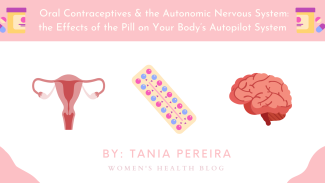Authors: Tania J. Pereira, PhD candidate, Women’s Cardiovascular Health lab at York University| Editors: Romina Garcia de leon, Shayda Swann (Blog Coordinators).
Published: November 4th, 2022
It has almost been 100 years since it was discovered that you could make an animal infertile by implanting an ovary from a pregnant animal. This discovery would be the basis for the birth control pill, although it wouldn’t be commercially available until the 1960’s. Since then, multiple variations (known as generations) have been created to reduce the side effects of birth control use – ranging from blood clotting to unwanted weight gain or acne and changes in mood. Thankfully, newer generations of birth control have been made with lower hormone levels – although some of the more minor health-related side effects persist.
While most side effects are physically visible, what about the unseen consequences?
Research suggests that within three months of use, birth control changes certain tissue volumes in specific regions of the brain. These regions control our emotions and how we manage emotional information. This means that birth control users could experience more negative and intense emotions. Birth control also changes the connections between different regions associated with higher cognitive function and emotional processing, meaning that birth control may alter mood by affecting how an individual regulates their emotions.
From these changes, it is understandable how birth control might affect a user’s mood – but could other functions also be altered?
My research focuses on how birth control alters the function of your autonomic nervous system, which controls all unconscious processes, such as heart rate, blood pressure or breathing. The autonomic nervous system is a network of the brain, neurons and the body’s organs. This system is also responsible for your “fight or flight” response.
More specifically, I am interested in how the body controls these processes in response to exercise. During exercise, key feedback about the physical movement and the metabolic environment of the exercising muscle are sent to the brain. This feedback is used to adjust your heart rate, blood pressure or breathing to support the exercise intensity.
Interestingly, birth control users have lower blood pressure responses to passive movement and handgrip exercise than non-users. Additionally, birth control users breathe more rapidly during handgrip exercise than non-users. Women generally do not increase their blood pressure during handgrip and other studies have observed that birth control rescues the blood pressure response. Both studies used similar exercises and performed the trials at similar times of their pill cycles (i.e., the birth control pill has an active dose phase ~21 days and a sugar pill or no-hormone phase ~7 days). Although, the types of birth controls used in each study were different; the first had increasing hormonal doses over the pill cycle, while the second had the same hormone dose with every pill.
While it is not clear what the effects of birth control are, both studies confirm that birth control use is altering the control of the body’s exercise response.
There is not a lot of research on birth control, and it is made more complicated by the fact that different types of oral contraceptives can have different effects. Additionally, birth control is not the only form of hormonal contraceptive. There are implants, injections, intrauterine devices, vaginal rings, and patches. Each unique method of administration could present unique altered effects.
My future research will aim to clarify some of these inconsistencies by more strictly controlling for phases, formulations and generations, as well as expanding the current body of knowledge on alternative hormonal contraceptives.
Hormones are a complex and fascinating aspect of women’s health that I hope to further explore.
